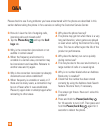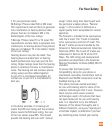
104
For Your Safety
Consumer Information About
Radio Frequency Emissions
Your wireless phone, which contains a
radio transmitter and receiver, emits radio
frequency energy during use. The following
consumer information addresses commonly
asked questions about the health effects of
wireless phones.
Are wireless phones safe?
Scientific research on the subject of
wireless phones and radio frequency (“RF”)
energy has been conducted worldwide for
many years, and continues. In the United
States, the Food and Drug Administration
(“FDA”) and the Federal Communications
Commission (“FCC”) set policies and
procedures for wireless phones. The FDA
issued a website publication on health
issues related to cell phone usage where it
states, “The scientific community at large
… believes that the weight of scientific
evidence does not show an association
between exposure to radiofrequency
(RF) from cell phones and adverse health
outcomes. Still the scientific community
does recommend conducting additional
research to address gaps in knowledge.
That research is being conducted around
the world and FDA continues to monitor
developments in this field. You can access
the joint FDA/FCC website at http://www.
fda.gov (under “c”in the subject index,
select Cell Phones > Research). You can
also contact the FDA toll-free at (888) 463-
6332 or (888) INFO-FDA. In June 2000, the
FDA entered into a cooperative research
and development agreement through
which additional scientific research is
being conducted. The FCC issued its own
website publication stating that “there
is no scientific evidence that proves that
wireless phone usage can lead to cancer
or a variety of other problems, including
headaches, dizziness or memory loss.” This
publication is available at http://www.fcc.
gov/cgb/ cellular.html or through the FCC at
(888) 225-5322 or (888) CALL-FCC.
What does “SAR” mean?
In 1996, the FCC, working with the FDA, the
U.S. Environmental Protection Agency, and
other agencies, established RF exposure
safety guidelines for wireless phones in the
United States. Before a wireless phone
model is available for sale to the public,
it must be tested by the manufacturer and
certified to the FCC that it does not exceed
limits established by the FCC. One of these
limits is expressed as a Specific Absorption
Rate, or “SAR.” SAR is a measure of the
rate of absorption of RF energy in the body.
Tests for SAR are conducted with the phone
transmitting at its highest power level in
all tested frequency bands. Since 1996, the
FCC has required that the SAR of handheld
wireless phones not exceed 1.6 watts per


















